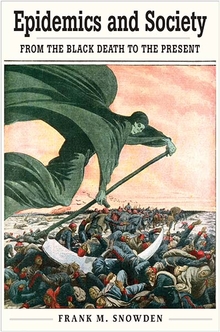The Health Care Debate and the Perils of Medicine for Profit
Frank M. Snowden—
Health care is key in the forthcoming US election, with polls indicating that the American people regard the issue—in tandem with the economy—as their top priority. Voters are seriously anxious about current provisions of care and worried about possible further efforts to undermine Obama’s Affordable Care Act. In such an environment, it is ironic that Bernie Sanders and Elizabeth Warren—the leading advocates of universal care (“Medicare for All”) among candidates—find themselves on the defensive.
Part of the problem is presentation. In debates and campaign appearances the two advocates of a single-payer system have too often adopted a negative approach. Too often they have used medical care as a proxy to demonize the insurance and pharmaceutical industries. This approach distracts attention from the overriding reasons that universal care is necessary, and it allows opponents to focus on narrow fiscal practicalities. Critics have indeed seized the opportunity to defend for-profit medicine on grounds of alleged economic prudence. Even progressive commentators such as the liberal economist Paul Krugman have argued that they will remain skeptical until they “see the money.”
As it happens, the economic argument for universal care is a strong one. One of the great objections to for-profit medicine is its enormous waste. Although America spends more than twice per capita on health care than other industrial nations, it lags far behind in leading health indicators such as life expectancy, infant mortality, and the availability of treatment. For instance, the CIA’s table ranking life expectancy in 224 countries places the United States in forty-third place. Similarly, World Bank figures for under-five mortality inform us that there are in America 6.5 deaths for every 1000 live births—double the rates in nations providing universal care such as Norway, Italy, and France. The US remains an outlier among industrial nations in terms of medical costs and outcomes. Over time, a single-payer system would pay for itself. How long are Americans prepared to accept “fake news” regarding the welfare state in Canada and western Europe with its supposed “death boards,” “communism,” lack of choice, and exorbitant taxation?
Sadly, a critical argument for universal care is rarely heard in the current debate. This is the issue of public health. Insight into the importance of universal care is provided by the HIV/AIDS epidemic. Paradoxically, although HIV/AIDS is now both treatable and preventable, in the US it remains—in the words of Science—“far from over.” 1.1 million Americans live with HIV; and there are nearly 40,000 new infections a year, and 6,000 AIDS-related deaths. Still more concerning, since 2010 HIV/AIDS has begun to regain momentum, led by the state of Florida. There the cities of Miami, Fort Lauderdale, Jacksonville, and Orlando stand at the epicenter of the upsurge.
The epidemiology of the resurgence of HIV/AIDS in Florida demonstrates the dangers of health care as a commodity. In the Sunshine State, the chief driver of this re-emergence of AIDS is a great upsurge of population groups beyond the reach of medical care—impoverished immigrants from Latin America and the Caribbean, homeless people, the mentally ill, and addicts to opioids and heroin. These groups, beyond the reach of the public health department, often have no idea that they are infected, and they are unable either to practice safe sex or to adhere to the long-term antiretroviral treatment regimens that could prevent HIV transmission to their partners. Multiple barriers of expense, education, language, transportation, and stigma isolate them from both preventative and curative medical care.
Indeed, Anthony Fauci, director of the National Institute of Allergy and Infectious Diseases, argues that HIV/AIDS could be rapidly eliminated from the United States if there were universal access to care. Thus, in February 2019 the CDC drafted a plan to eliminate AIDS—its “Ending the HIV Epidemic Initiative.” Tellingly, all four pillars of this initiative depend on universal access to care—early diagnosis, rapid treatment, protection of individuals at risk, and rapid response to growing HIV clusters. Absent such a comprehensive system, the epidemic will persist, inflicting enormous cost and suffering.
Transmission of HIV in Florida sounds an alarm for the future as well as the present. We live in an era of rapid climate change, population growth, mass air travel, and ever more numerous emerging diseases. The list covers the length from A to Z—from Avian flu to Zika. Furthermore, since the microbial world is constantly evolving, the emergence of new bacterial and viral challenges is inevitable. The question is no longer whether severe challenges will appear, but rather whether society will be equipped to face them.
In this regard, the spread of HIV among marginalized Floridians illustrates the manner in which virulent infections can establish themselves and circulate silently long before public health officials become aware. In the modern world, when confronted with a new disease, safety depends critically on prompt and accurate information that alone allows the tools of public health—isolation, treatment, contact tracing, vaccination—to be deployed. Such rapid response will be all the more necessary if the next microbial invader is exceptionally virulent, easily transmissible, and endowed with a significant incubation period. Since virologists anticipate that the next major microbial threat is likely to be an airborne viral pathogen, possibly resembling the Spanish influenza after World War I, successful containment will depend critically on early response. Substantial gaps in health care would be the public health equivalent of standing down the sentinels and risking a widespread catastrophe. So far in the twenty-first century, we have been fortunate in that the greatest epidemic threats to date—SARS and Ebola—have not been so readily transmissible as the “Spanish Lady.” But we cannot expect so fortunate a pattern to recur, and comprehensive health care is the front line of defense, providing surveillance and rapid response. Public health officials suggest that a new influenza epidemic of the Spanish kind, or worse, could cause 33 million deaths in half a year.
Frank M. Snowden is Andrew Downey Orrick Professor Emeritus of History and History of Medicine at Yale University. His previous books include The Conquest of Malaria: Italy, 1900–1962 and Naples in the Time of Cholera, 1884–1911.
Further Reading:



























